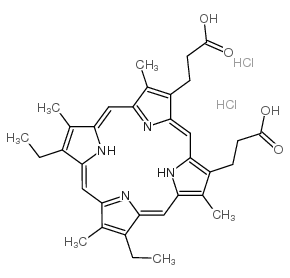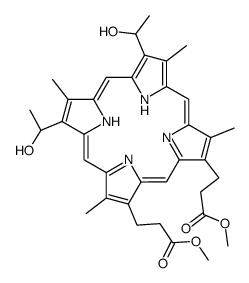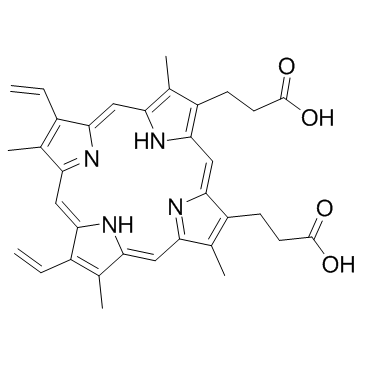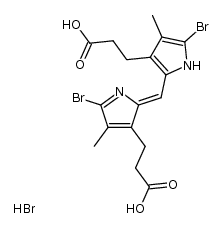1263-63-4
| Name | Mesoporphyrin IX dimethyl ester,Dimethyl 8,13-bis(ethyl)-3,7,12,17-tetramethyl-21H,23H-porphine-2,18-dipropionate |
|---|---|
| Synonyms |
2,18-Porphinedipropionic acid,7,12-diethyl-3,8,13,17-tetramethyl-,dimethyl ester
Dimethyl 8,13-diethyl-3,7,12,17-tetramethyl-21H,23H-porphine-2,18-dipropionate mesoporphyrin-(IX)-dimethylester EINECS 215-030-1 DIMETHYL 7,12-DIETHYL-3,8,13,17-TETRAMETHYL-21 H,23 H-PORPHINE-2,18-DIPROPIONATE DIMETHYL 8,13-BIS(ETHYL)-3,7,12,17-TETRAMETHYL-21H,23H-PORPHINE-2,18-DIPROPIONATE Mesoporphyrin dimethyl ester MFCD00010036 23h-porphine-2,18-dipropanoicacid,7,12-diethyl-3,8,13,17-tetramethyl-21di MESOPORPHYRIN IX DIMETHYL ESTER,SYNTHET IC |
| Density | 1.171g/cm3 |
|---|---|
| Boiling Point | 1009.8ºC at 760mmHg |
| Melting Point | 215ºC |
| Molecular Formula | C36H42N4O4 |
| Molecular Weight | 594.74300 |
| Flash Point | 564.5ºC |
| Exact Mass | 594.32100 |
| PSA | 108.90000 |
| LogP | 4.25190 |
| Vapour Pressure | 0mmHg at 25°C |
| Index of Refraction | 1.582 |
|
Section 1: Product Identification Chemical Name:Mesoporphyrin IX, dimethyl ester, 97% CAS Registry Number:1263-63-4 Formula:C36H42N4O4 EINECS Number:215-030-1 Chemical Family:porphine (porphyrin) ligand Synonym:Dimethyl 7,12-diethyl-3,8,13,17-tetramethyl-21H,23H-porphine- 2,18-dipropionate
Section 2: Composition and Information on Ingredients IngredientCAS NumberPercentACGIH (TWA)OSHA (PEL) Title Compound1263-63-4100%no datano data Section 3: Hazards Identification Emergency Overview:No particular hazard associated with this material. Primary Routes of Exposure:Ingestion, inhalation Eye Contact:May cause slight to mild irritation of the eyes. Skin Contact:May cause slight to mild irritation of the skin. Inhalation:May be irritating to the nose, mucous membranes and respiratory tract. Ingestion:No specific information is available on the physiological effects of ingestion. Acute Health Affects:May be irritating to skin, eyes and respiratory tract. Chronic Health Affects:No information available on long-term chronic effects. NTP:No IARC:No OSHA:No SECTION 4: First Aid Measures Immediately flush the eyes with copious amounts of water for at least 10-15 minutes. A victim may need Eye Exposure: assistance in keeping their eye lids open. Get immediate medical attention. Wash the affected area with water. Remove contaminated clothes if necessary. Seek medical assistance if Skin Exposure: irritation persists. Remove the victim to fresh air. Closely monitor the victim for signs of respiratory problems, such as difficulty Inhalation: in breathing, coughing, wheezing, or pain. In such cases seek immediate medical assistance. Seek medical attention immediately. Keep the victim calm. Give the victim water (only if conscious). Induce Ingestion: vomiting only if directed by medical personnel. SECTION 5: Fire Fighting Measures Flash Point:no data Autoignition Temperature:none Explosion Limits:none Extinguishing Medium:carbon dioxide, dry powder or foam If this material is involved in a fire, fire fighters should be equipped with a NIOSH approved, positive pressure Special Fire Fighting Procedures: self contained breathing apparatus and full protective clothing. Hazardous Combustion andIf involved in a fire this material may emit toxic organic fumes. Decomposion Products: Unusual Fire or Explosion Hazards: No unusual fire or explosion hazards. SECTION 6: Accidental Release Measures Spill and Leak Procedures:Small spills can be mixed with vermiculite or sodium carbonate and swept up. SECTION 7: Handling and Storage Handling and Storage:Store in a tightly sealed container. Keep away from heat and direct sunlight. SECTION 8: Exposure Controls and Personal Protection Eye Protection:Always wear approved safety glasses when handling a chemical substance in the laboratory. Skin Protection:Wear protective clothing and gloves. Ventilation:Material may form a fine dust. If possible, handle the material in an efficient fume hood. If ventilation is not available a respirator should be worn. The use of respirators requires a Respirator Respirator: Protection Program to be in compliance with 29 CFR 1910.134. Ventilation:Material may form a fine dust. If possible, handle the material in an efficient fume hood. Additional Protection:No additional protection required. SECTION 9: Physical and Chemical Properties Color and Form:purple xtl. Molecular Weight:594.76 Melting Point:215° Boiling Point:no data Vapor Pressure:no data Specific Gravity:no data Odor:none Solubility in Water:insoluble SECTION 10: Stability and Reactivity Stability:air and moisture stable solid Hazardous Polymerization:no hazardous polymerization Conditions to Avoid:none Incompatibility:oxidizing agents Decomposition Products:carbon dioxide, carbon monoxide, nitrogen oxides, and organic fumes SECTION 11: Toxicological Information RTECS Data:No information available in the RTECS files. Carcinogenic Effects:No data available Mutagenic Effects:No data available Tetratogenic Effects:No data available SECTION 12: Ecological Information Ecological Information:No information available SECTION 13: Disposal Considerations Disposal:Dispose of according to local, state and federal regulations. SECTION 14: Transportation Shipping Name (CFR):Non-hazardous Hazard Class (CFR):NA Additional Hazard Class (CFR):NA Packaging Group (CFR):NA UN ID Number (CFR):NA Shipping Name (IATA):Non-hazardous Hazard Class (IATA):NA Additional Hazard Class (IATA):NA Packaging Group (IATA):NA UN ID Number (IATA):NA SECTION 15: Regulatory Information TSCA:Listed in the TSCA inventory. SARA (Title 313):Not reportable under SARA Title 313 Second Ingredient:none SECTION 16 - ADDITIONAL INFORMATION N/A |
| Safety Phrases | S24/25 |
|---|
|
~% 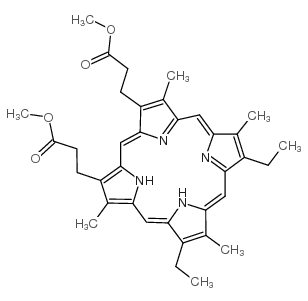
1263-63-4 |
| Literature: Hoppe-Seyler's Zeitschrift fuer Physiologische Chemie, , vol. 37, p. 54,69, 71 Journal of the American Chemical Society, , vol. 68, p. 2473,2475 Journal of Biological Chemistry, , vol. 172, p. 717,723 Justus Liebigs Annalen der Chemie, , vol. 459, p. 96 |
|
~% 
1263-63-4 |
| Literature: Australian Journal of Chemistry, , vol. 44, # 3 p. 411 - 426 |
|
~% 
1263-63-4 |
| Literature: Justus Liebigs Annalen der Chemie, , vol. 548, p. 183,190 |
|
~% 
1263-63-4 |
| Literature: Chemische Berichte, , vol. 61, p. 2509,2516 |
|
~82% 
1263-63-4 |
| Literature: Byrne, Christopher J.; Ward, A. David Tetrahedron Letters, 1988 , vol. 29, # 12 p. 1421 - 1424 |
|
~% 
1263-63-4 |
| Literature: Justus Liebigs Annalen der Chemie, , vol. 459, p. 96 |
|
~% 
1263-63-4 |
| Literature: Journal of the Chemical Society, Perkin Transactions 1: Organic and Bio-Organic Chemistry (1972-1999), , p. 2864 - 2870 |
|
~% 
1263-63-4 |
| Literature: Journal of the Chemical Society, Perkin Transactions 1: Organic and Bio-Organic Chemistry (1972-1999), , p. 2864 - 2870 |
|
~% 
1263-63-4 |
| Literature: Acta Chemica Scandinavica (1947-1973), , vol. 4, p. 1221,1224 Justus Liebigs Annalen der Chemie, , vol. 537, p. 250,253,259 Justus Liebigs Annalen der Chemie, , vol. 541, p. 196,199 |
